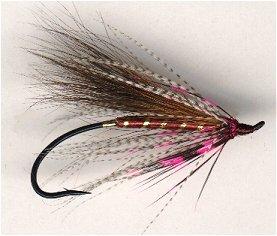
On The Fly
"Fly tying is a school from which we never graduate"
TYING NEWS
Mark Teeters was our guest tier at the October SOFT meeting in Gold Hill on Tuesday the 14th. He showed us how to tie an October Caddis fall steelhead fly in a tie-along session. I encourage novice and experienced tiers alike to drop by the second Tuesday of each month at 6 p.m. for a fun evening. We have plenty of room for everyone. If you are interested in this educational experience, contact me and we will add your name to our e-mail notification list. We can then let you know who, when, and what materials to bring.
 PATTERN OF THE MONTH - Mover
PATTERN OF THE MONTH - Mover
Hook: Daiichi 2421 or equivalent light wire salmon/steelhead hook, size 6-2.
Thread: Claret 6/0.
Tag: Oval gold tinsel, small.
Body: Claret floss.
Rib: Oval gold tinsel.
Wing: Red squirrel tail.
Collar: Natural Lemon Wood duck flank, followed by shorter guinea fowl dyed claret.
Head: Claret thread.
Tying Instructions:
1) Start the thread two eye-widths back from the eye. Lay down a thread layer covering 2/3 the
shank length.
2) Tie in the oval gold tinsel, wind it 4 turns back toward the hook bend and then forward to
the thread. Tie off and let the tinsel hang. Advance the thread to just behind the eye.
3) Tie in the claret floss, wind it back to the tag, then reverse the direction and wind a
second layer to just behind the eye. Tie off and trim.
4) Wind the oval gold tinsel forward in 5 evenly spaced turns. Tie off and trim.
5) Select a small bunch of red squirrel tail, trim to length so tips are 3/4 the shank length,
and tie in the squirrel tail material on top of the shank at two eye-widths behind the hook eye.
6) Select a Wood duck feather with barbs long enough to reach the wing tips. Tie on the feather
and wind it 2 turns to form the under collar.
7) Select a claret dyed guinea feather with barbs shorter than the Wood duck. Tie on the feather
and wind it 2 turns to form the over collar.
8) Form a small, neat head with claret thread. Whip finish the thread and apply cement.
The Mover fly was developed by Tim Colman of Linwood, Washington, in 1986, for the North Fork of the Stillaguamish. Since that time the pattern has proven itself on many West Coast steelhead waters for summer fish into the late fall. It is generally tied low-water style with sparse materials and the body tied short on the shank. The claret color provides enough of a dark profile with just enough color and flash to attract attention.
TYING TIPS
This fly is a perfect example of how you can take your favorite steelhead pattern and modify
materials to create a low-water version. Just follow these simple guidelines: shorten the
body on the hook shank; thin out the body by using floss or poly yarn instead of chenille;
reduce the number of wing fibers by 1/2 and reduce the angle; and, use soft hackle materials
with 1/2 as many turns. Tie some up, give them a test flight and let me know how you do.
Tie One On,
Dan Kellogg (you can contact me at FLYGUY@EZNORTHWEST.COM)